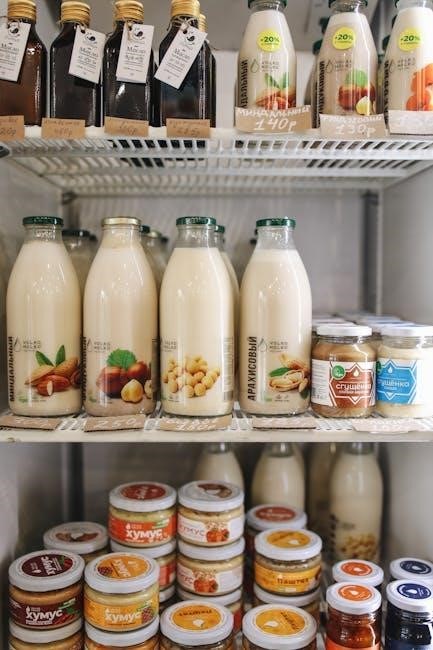A Refrigerator Temperature Log Sheet is a tool used to monitor and record refrigerator and freezer temperatures, ensuring food safety and regulatory compliance. It helps maintain consistent temperature control and provides a reliable record for audits and quality assurance. Using a log sheet is essential for businesses and households to track temperature accuracy and prevent food spoilage.
1.1 What is a Refrigerator Temperature Log Sheet?
A Refrigerator Temperature Log Sheet is a document used to record and monitor the temperature of refrigerators and freezers over time. It provides a structured format to track temperature readings, ensuring consistency and accuracy. The log sheet typically includes columns for date, time, temperature readings, units of measurement (Fahrenheit or Celsius), and corrective actions if temperatures fall outside the ideal range. This tool is essential for maintaining food safety, preventing spoilage, and meeting regulatory requirements. It is widely used in restaurants, laboratories, medical facilities, and homes to ensure optimal storage conditions. By documenting temperature data, users can identify potential issues early and take prompt action to maintain safe and consistent refrigeration levels.
1.2 Importance of Maintaining Accurate Records
Maintaining accurate temperature records is crucial for ensuring food safety, preventing spoilage, and meeting regulatory requirements. By regularly documenting refrigerator and freezer temperatures, users can quickly identify deviations from safe ranges, allowing prompt corrective actions to protect stored items. Accurate records also serve as evidence of compliance with health and safety standards during audits. This documentation helps prevent foodborne illnesses, reduces waste, and ensures the quality of perishable goods. Consistent logging also aids in identifying equipment malfunctions early, minimizing potential losses. For businesses, precise records demonstrate adherence to quality control measures, safeguarding reputation and customer trust. Ultimately, accurate temperature logging is a vital practice for maintaining safety, efficiency, and compliance in both professional and home settings.

Ideal Temperature Ranges
The ideal refrigerator temperature is 40°F (4°C), with a range of 37°F to 40°F (3°C to 4°C). The freezer should be at 0°F (-18°C), with a range of -10°F to 0°F (-23°C to -18°C). Consistent temperatures ensure food safety and quality.
2.1 Refrigerator Temperature Guidelines
The ideal temperature range for a refrigerator is between 35°F and 40°F (2°C to 4°C), with 40°F (4°C) being the optimal temperature for food safety. Temperatures outside this range can lead to food spoilage or bacterial growth. It is crucial to ensure the refrigerator operates within these guidelines to maintain the quality and safety of stored items. Regular checks using a calibrated thermometer are recommended to verify accuracy. If the temperature deviates from the recommended range, corrective actions such as adjusting settings or inspecting door seals should be taken promptly. Consistent monitoring helps prevent potential health risks and ensures compliance with food safety standards.
2.2 Freezer Temperature Recommendations
The ideal temperature range for a freezer is between -10°F and 0°F (-23°C to -18°C), with 0°F (-18°C) being the optimal temperature for preserving food quality and safety. Freezers operating at temperatures above 0°F risk causing ice crystal formation in frozen foods, leading to degradation. Conversely, temperatures below -10°F may not be necessary for standard household or commercial use and can increase energy consumption. Regular monitoring with a calibrated thermometer is essential to ensure the freezer remains within this range. Deviations from the recommended temperature can result in food spoilage or safety hazards, necessitating prompt corrective actions such as adjusting settings or addressing potential malfunctions. Maintaining consistent freezer temperatures is critical for long-term food preservation and safety.

How to Use a Temperature Log Sheet
Download and print the PDF template, then record refrigerator and freezer temperatures regularly. Use a calibrated thermometer, note date, time, and corrective actions if needed; Ensure accuracy and consistency for food safety compliance.
3.1 Steps to Access and Download PDF Templates
To access and download free printable refrigerator temperature log sheet templates, visit websites like Formsbank or Microsoft Office Online. Search for “refrigerator temperature log sheet PDF” and select a template that suits your needs. Download the template in PDF or Word format, depending on your preference. Ensure the template includes fields for date, time, temperature readings, and corrective actions. Some templates are fillable online, allowing you to type directly into the form before printing. Save the template to your device or cloud storage for easy access and future use. Many templates are customizable, enabling you to tailor them to your specific requirements. Print the template on standard paper for manual recording or use electronic versions for digital logging.
3.2 How to Read and Record Temperatures
To accurately read and record temperatures, use a calibrated thermometer and place it in the center of the refrigerator or freezer, away from direct contact with food or walls. Allow the thermometer to stabilize for a few minutes before taking a reading. Note the temperature in the designated log sheet, ensuring to include the date, time, and your initials. Record temperatures at least twice daily, ideally during consistent times such as morning and evening. Reference the optimal temperature ranges (35-40°F for refrigerators and -10 to 0°F for freezers) and document any deviations. If temperatures fall outside the safe range, note the corrective actions taken. Consistent and accurate logging ensures food safety and compliance with health regulations.

Features of Printable Templates
Printable templates offer customizable fields, fillable PDF forms, and printer-friendly designs. They include sections for date, time, temperature readings, and corrective actions, ensuring organized and clear documentation.
4.1 Key Elements of a Log Sheet
A log sheet typically includes date, time, temperature readings, and units (Fahrenheit or Celsius). It features sections for corrective actions, initials, and notes for accountability. Fillable PDF forms allow easy data entry, while printer-friendly layouts ensure clarity. The template often includes optimal temperature ranges and space for recording multiple readings per day. Clear columns and rows enhance organization, making it easy to track trends and ensure compliance with safety standards. These elements help maintain precise records, supporting food safety and regulatory requirements effectively.
4.2 Benefits of Using Fillable PDF Forms
Fillable PDF forms offer convenience and efficiency, allowing users to input data directly without printing. They reduce errors by providing structured fields for date, time, and temperature readings. Digital tools enable easy editing, highlighting, and blacking out sensitive information. These forms can be saved and shared electronically, promoting organized record-keeping. Cloud storage integration ensures accessibility and backup of temperature logs. Fillable PDFs streamline the logging process, making it quicker and more accurate compared to manual entry. They are ideal for businesses requiring consistent and professional documentation, while also catering to home users seeking simplicity and reliability in temperature tracking.

Tools and Equipment Needed
To effectively use a refrigerator temperature log sheet, you need a calibrated thermometer for accurate readings, a printer to produce the log, and a pen for recording data. A clipboard can also be useful for mobile documentation.
5.1 Calibrated Thermometers for Accuracy
A calibrated thermometer is essential for ensuring precise temperature readings in your refrigerator and freezer. Regular calibration guarantees accuracy and reliability, which are critical for maintaining food safety and preventing spoilage. Use a high-quality thermometer that can be calibrated annually or as recommended by the manufacturer. This tool is vital for verifying that your appliance operates within the ideal temperature ranges, ensuring compliance with food safety regulations. Always source thermometers from reputable suppliers or online stores to ensure reliability. Without a calibrated thermometer, temperature readings may be inaccurate, leading to unsafe storage conditions; Invest in a reliable thermometer to maintain accurate records and ensure your refrigerator and freezer function optimally.
5.2 Printer Requirements for Printing Logs
A reliable printer is necessary for printing refrigerator temperature log sheets. Ensure your printer is compatible with PDF formats, as most templates are designed in this format. Use a standard inkjet or laser printer for clear and legible output. Print on 8.5×11-inch paper for optimal readability. Adjust printer settings to ensure high-quality text and grids. Regularly check ink or toner levels to avoid faded prints. For best results, use standard printer settings and avoid scaling the document; Ensure the printer is calibrated to maintain consistent and accurate prints. Clear and legible logs are essential for maintaining precise records and ensuring food safety compliance. Always test print a sample before printing multiple copies to verify quality.

Best Practices for Logging Temperatures
Consistently log temperatures at regular intervals using a calibrated thermometer. Document readings accurately and note any deviations. Train staff to follow procedures and maintain organized records for compliance.
6.1 Frequency of Temperature Checks
Regular temperature checks are crucial to ensure food safety. For refrigerators, temperatures should be recorded at least twice daily, preferably morning and evening. Freezers require daily checks to maintain optimal conditions. Some businesses may opt for more frequent monitoring, especially in high-traffic environments. Consistent logging helps identify trends and potential issues early, preventing food spoilage and ensuring compliance with health regulations. Using a printable temperature log sheet simplifies this process, allowing staff to quickly document readings and maintain organized records. Adjust the frequency based on specific needs, such as after power outages or equipment malfunctions.
6.2 Staff Training for Consistent Logging
Proper staff training is essential for consistent and accurate temperature logging. Train employees to understand the importance of maintaining optimal temperature ranges and the consequences of improper logging. Ensure staff know how to use calibrated thermometers and correctly fill out log sheets. Emphasize the frequency of checks and the need for immediate corrective actions if temperatures fall out of range. Provide hands-on training sessions and distribute printable guides or templates for reference. Regular refreshers and updates on new procedures will help maintain consistency and compliance. Well-trained staff are key to ensuring food safety and preventing potential health hazards.

Corrective Actions
Corrective actions are essential when temperatures fall outside the ideal range. Identify the issue, document it, and take immediate steps to restore optimal conditions. Schedule maintenance if needed.
7.1 Responding to Out-of-Range Temperatures

When refrigerator or freezer temperatures fall outside the ideal range, prompt action is crucial to prevent food spoilage and ensure safety. First, verify the reading with a calibrated thermometer to confirm accuracy. If the temperature is too high or low, adjust the appliance settings and monitor closely. Check for issues like faulty door seals, overloaded shelves, or malfunctioning components. Document the issue, corrective measures taken, and follow-up checks in the temperature log sheet. Ensure staff are trained to recognize and address deviations swiftly. If the problem persists, contact maintenance or replace the unit to maintain food quality and safety standards.
7.2 Documenting and Following Up on Issues
Accurate documentation of temperature deviations and corrective actions is essential for accountability and compliance. When issues arise, record the date, time, and specific temperature readings in the log sheet. Note the corrective measures taken, such as adjusting settings or contacting maintenance. Ensure all entries are clear, concise, and signed by the responsible individual. Schedule follow-up checks to verify resolved issues and maintain consistency. Regularly review logged data to identify recurring problems and implement preventive measures. This systematic approach ensures ongoing compliance with safety standards and demonstrates due diligence in maintaining proper temperature control. Consistent documentation also aids in audits and provides a traceable record of all actions taken to address temperature-related concerns.

Digital Solutions
Digital tools like electronic logging systems and cloud storage enhance temperature monitoring efficiency. They allow real-time data access, automated alerts, and seamless record-keeping, improving compliance and organization.
8.1 Using Electronic Logging Systems
Electronic logging systems offer a modern, efficient way to monitor and record refrigerator and freezer temperatures. These systems automate data collection, reducing manual entry and errors. They provide real-time temperature monitoring, enabling prompt responses to deviations. Automated alerts notify staff of out-of-range temperatures, ensuring food safety. Cloud-based solutions allow access to temperature logs from any device, enhancing transparency and organization. These systems also generate reports for audits and compliance purposes. By integrating with thermometers and sensors, electronic logging ensures accurate, continuous data capture. This eliminates the need for paper-based logs, streamlining operations and improving record-keeping. Businesses can customize settings and access historical data, making it easier to maintain consistent temperature control and comply with safety standards.
8.2 Cloud Storage for Record Keeping
Cloud storage offers a secure and accessible way to manage refrigerator and freezer temperature logs. By storing records online, businesses can easily access data from any device, ensuring transparency and organization. Cloud-based solutions allow multiple users to view and edit logs, fostering collaboration. Automated backups prevent data loss, and encryption enhances security. This method is ideal for maintaining audit trails and complying with regulatory requirements. Cloud storage also enables easy sharing of temperature logs with auditors or health inspectors. Additionally, it reduces physical storage needs and ensures records are centrally located. This modern approach streamlines record-keeping, making it easier to track and maintain temperature data efficiently. Cloud storage complements electronic logging systems, providing a comprehensive solution for temperature management and compliance.
Using a PDF free printable refrigerator temperature log sheet ensures food safety, consistency, and compliance. Regular logging helps prevent spoilage and maintains optimal storage conditions for perishables.
9.1 Summary of Key Points
Using a PDF free printable refrigerator temperature log sheet is crucial for maintaining food safety and compliance. Key points include monitoring fridge and freezer temps, ensuring accuracy with calibrated thermometers, and recording data regularly. Optimal fridge temps are 35-40°F, while freezers should be 0°F or colder. Consistent logging prevents spoilage and ensures food quality. Templates are easily downloadable and customizable for various settings, from homes to businesses. Regular audits and staff training enhance compliance. Digital solutions like fillable PDFs and cloud storage simplify record-keeping. Corrective actions for out-of-range temps are essential to maintain safety standards. Overall, these log sheets are vital tools for effective temperature management and food safety.
9.2 Final Tips for Effective Temperature Management
Regularly calibrate thermometers to ensure accuracy and reliability. Conduct temperature checks at consistent intervals, ideally twice daily, to maintain food safety. Train staff to recognize and respond to out-of-range temperatures promptly. Use downloadable PDF templates to streamline logging and ensure compliance with health regulations. Store completed logs securely, either physically or digitally, for easy access during audits. Customize templates to fit specific needs, such as adding columns for corrective actions or notes. Prioritize maintaining a clean and organized refrigerator to prevent temperature fluctuations. By following these tips, you can ensure effective temperature management, reduce food waste, and uphold high safety standards in both residential and commercial settings.

Additional Resources
Visit websites like formsbanks.com or template.net for free downloadable refrigerator temperature log sheets. These sites offer customizable templates and comprehensive guides to help you manage temperature records effectively.
10.1 Websites for Downloading Templates
Several websites offer free, customizable refrigerator temperature log sheet templates in PDF and Word formats. Popular options include formsbanks.com, template.net, and pdftemplate.net. These platforms provide pre-designed templates that can be easily edited online or downloaded for printing. Many templates are fillable PDFs, allowing users to input data directly before saving or printing. Some websites also offer cloud storage integration, enabling seamless access and sharing of temperature logs. Additionally, these sites often include instructions and guidelines for proper usage, ensuring accurate and consistent temperature recording. Whether for commercial or personal use, these resources make it easy to maintain precise temperature monitoring and adhere to food safety standards. Visit these websites to explore their collections and download the template that best suits your needs.
10.2 Recommended Books and Guides
For in-depth knowledge on temperature management, several books and guides are highly recommended. Titles like “Food Safety Management: A Practical Guide for the Food Industry” and “Temperature Control for Food Safety” provide comprehensive insights into maintaining optimal refrigerator and freezer temperatures. These resources often include practical tips, regulatory compliance guidelines, and best practices for logging temperatures. Additionally, “The Food Safety Handbook” by local health departments offers detailed instructions for businesses and households. Many of these guides are available online through retailers like Amazon or Barnes & Noble, or as digital downloads. They are invaluable for ensuring food safety and proper temperature monitoring. These books complement the use of temperature log sheets, offering a well-rounded approach to effective temperature management.

